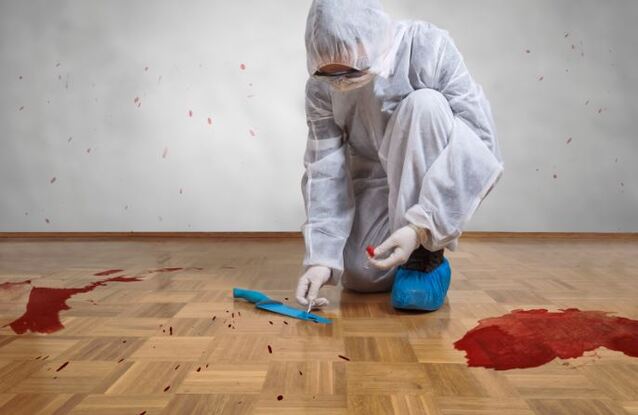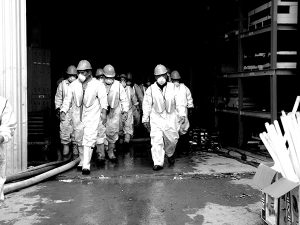Specialist Blood Cleanup: Ensuring Safe and Thorough Decontamination
Specialist Blood Cleanup: Ensuring Safe and Thorough Decontamination
Blog Article
Expert Biohazard Cleaning and Purification for Blood, Bodily Fluids, and Hazardous Materials
The potential health and wellness threats connected with direct exposure to biohazards underscore the important need for precise handling and thorough clean-up. As we browse the intricate landscape of biohazard clean-up, understanding the nuances of regulations, conformity, and the specialized devices at play becomes imperative in making certain a safe and extensive decontamination process.
Wellness Dangers of Biohazard Direct Exposure
Exposure to biohazards postures significant wellness risks that can lead to serious effects for people and areas alike. Biohazards encompass a large array of organic materials, consisting of blood, physical liquids, mold, bacteria, viruses, and other potentially contagious products. When people enter into call with these biohazards, whether via crashes, improper handling, or environmental exposure, they face the risk of contracting major health problems or conditions.
Among the main health and wellness dangers related to biohazard direct exposure is the transmission of transmittable conditions. Bloodborne virus such as HIV, liver disease B and C, and various bacteria can be existing in biohazardous materials, posing a direct risk to human health and wellness. Breathing in airborne biohazards like mold spores or entering contact with polluted surfaces can likewise cause respiratory system concerns, allergies, and other unfavorable health impacts.
Moreover, biohazard exposure can have long-lasting health implications, with some conditions manifesting years after the initial get in touch with (Blood Cleanup). As a result, it is crucial to prioritize proper biohazard cleaning and decontamination to alleviate these health and wellness dangers and guarantee the safety of individuals and communities

Specialized Training for Biohazard Cleaning
When it pertains to managing biohazard cleanup successfully and safely, specialized training plays a basic function in making certain correct purification procedures are adhered to. Biohazard cleanup needs details understanding and abilities to efficiently minimize risks connected with bloodborne virus, physical fluids, and harmful materials. Professionals learnt biohazard clean-up undertake rigorous direction on how to safely manage, get rid of, and deal with biohazardous materials to avoid contamination and direct exposure.
Specialized training for biohazard cleaning covers a series of essential topics, including proper personal safety tools (PPE) use, bloodborne pathogen recognition, purification strategies, and contaminated materials disposal methods. People educated in biohazard clean-up are furnished with the needed experience to analyze contamination degrees, determine prospective dangers, and carry out proper clean-up procedures in conformity with governing criteria.
Constant training and education are critical in the field of biohazard cleaning to remain updated on the newest decontamination technologies, safety and security procedures, and policies. By buying specialized training, biohazard cleaning experts can efficiently react to emergency situation clean-up scenarios and protect both public health and wellness and the environment.
Significance of Proper Purification Strategies
Utilizing proper purification techniques is vital in biohazard cleaning to effectively minimize and get rid of harmful materials health and wellness threats. Efficient purification not only ensures the removal of noticeable traces of blood, bodily liquids, and other biohazards however also targets undetectable pathogens that may pose severe wellness risks otherwise correctly removed. By following rigid purification protocols, educated professionals can dramatically decrease the threat of exposure to unsafe microorganisms, infections, and bacteria that might result in conditions or infections.
Proper decontamination strategies involve the use of customized equipment and anti-bacterials that are especially developed to counteract biohazards effectively. Complete cleansing and disinfection of infected areas are important to avoid the spread of virus and guarantee a risk-free setting for residents. Furthermore, the proper disposal of biohazardous waste complying with decontamination procedures is important in protecting against contamination of various other surface areas or people.

Equipment and Devices for Safe Cleaning
When dealing with blood, physical liquids, or dangerous products, biohazard cleaning experts count on specialized gear to lessen exposure dangers and extensively decontaminate the afflicted location. click to investigate Additionally, biohazard cleansing packages including anti-bacterials, absorbing materials, and biohazard bags are utilized to securely contain and dispose of contaminated products.
Advanced cleansing devices like hospital-grade disinfectants, HEPA-filtered vacuums, and misting equipments are employed to sterilize surface areas and get rid of biohazards efficiently. Specialized devices such as sharps containers and biohazard garbage disposal containers are utilized to securely take care of sharp objects and biohazardous waste materials. By making use of the appropriate equipment and tools, biohazard cleaning experts can ensure a thorough cleanup procedure that focuses on safety and security and decreases wellness threats for both employees and residents of the find affected space.
Laws and Compliance in Biohazard Cleaning
Proper adherence to regulations and compliance standards is critical in biohazard cleansing to ensure the safety and security of both personnel and the environment. Government agencies such as OSHA (Occupational Safety And Security and Wellness Management) and the EPA (Epa) have actually developed certain guidelines for biohazard cleanup procedures to minimize wellness threats and ecological contamination. These guidelines cover a variety of aspects including the handling, transport, and disposal of biohazardous products, in addition to the required training and protective equipment required for employees included in the clean-up process.
Biohazard cleansing firms need to stay up-to-date with these laws to assure that their operations meet the called for security requirements. Failure to abide by these laws can cause serious repercussions, including penalties, lawsuit, and endangering the wellness of individuals and the environment. By adhering to strict regulations and conformity procedures, biohazard cleaning firms can properly alleviate dangers and guarantee a safe and detailed cleaning procedure for all celebrations involved.
Conclusion
In conclusion, biohazard cleaning and purification call for specific training, appropriate methods, and adherence to regulations. Direct exposure to blood, bodily liquids, and unsafe products positions substantial health and wellness risks, making it vital to utilize the right devices and tools for secure clean-up. By adhering to strict procedures and standards, experts can properly reduce the threats associated with biohazard direct exposure and make sure the safety and security of both themselves and others.
As we navigate the detailed landscape of biohazard cleanup, comprehending the subtleties of regulations, compliance, and the customized equipment at play ends up being essential in making navigate here certain a safe and detailed purification process. (Blood Cleanup)
When it comes to dealing with biohazard clean-up successfully and securely, specialized training plays a fundamental role in making certain proper decontamination treatments are adhered to.Making use of correct purification strategies is critical in biohazard cleaning to effectively decrease and remove unsafe products health and wellness dangers. Furthermore, biohazard cleaning kits containing disinfectants, absorbing products, and biohazard bags are utilized to safely get rid of and consist of of polluted products.
Government agencies such as OSHA (Occupational Safety And Security and Wellness Administration) and the EPA (Environmental Protection Firm) have actually established specific standards for biohazard cleaning procedures to minimize wellness threats and ecological contamination.
Report this page